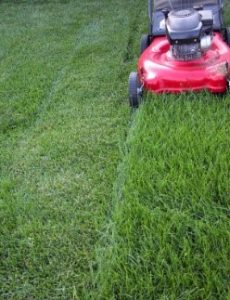Mow correctly for a healthy, attractive lawn.
Proper mowing techniques help create a lush, dense lawn that is naturally resistant to drought, weeds and disease. This dramatically reduces the need for adding water and chemicals – saving you time and money while protecting the environment.
Mowing with a dull blade causes serious harm to your lawn, making it weak and susceptible to drought, weeds and disease. Many of us try to repair the damage by adding water, fertilizer, chemicals and pesticides. It’s much easier on you, your wallet and the environment if you mow correctly and don’t cause damage in the first place.
Mow with a sharp mower blade.
For almost forty years, NSRWA has been the voice advocating for the health of the North and South rivers- protecting them from actions that could harm or degrade water quality and water quantity. Here is a sample of just a few of the actions NSRWA has initiated over the years:
Dull blades rip and tear your lawn instead of cutting it, causing disease, serious stress and damage. Look closely at a blade of your grass – if the top edge is frayed and shows split ends, your blade is dull and causing damage to the grass. Use the “thumb test” to see if your mower blade is sharp enough to crease your skin. Whenever your blade is dull, switch to a spare sharpened blade. Be prepared to change your mower blade frequently by keeping the necessary wrench handy as well as a spare blade that is already sharpened. You can do this yourself if you have the time, or for very little money you can have it done professionally. Google “Lawn Mowers-Sharpening & Repairing” — most places that repair lawn mowers also sharpen blades and sell spares.
Mow frequently and not more than 1/3 of the height at once.
Frequent mowing results in an attractive lawn and causes the least stress to the grass. Mow often enough that you never remove more than an inch, otherwise you will shock your lawn and weaken its resistance to drought, weeds and disease. If the height of your lawn gets very long, cut it down to the proper height in stages, no more than 1/3 of the total height at a time.
Keep your grass 3 inches tall.
Credit cards are about 3 inches; use one to measure your grass!
Taller grass has deeper, healthier roots. It is also denser and naturally crowds out weeds (especially crabgrass) and shades the soil so it retains moisture. When your grass is 3 1/2” (just taller than a credit card), mow it down to 3”. The necessary mowing frequency will vary greatly through the season; it can even be different between your frontyard and backyard.
Use a mulching mower and leave grass clippings on the lawn.
Mulching mowers create fine grass clippings that break down and add nitrogen and organic matter to the soil. Grass clippings are approximately 85% water, so they decompose quickly and will not smother your lawn. Grass clippings are a free and easy way to provide the equivalent of one regular fertilizer application each year, and will not cause thatch (thatch is an indicator of too much fertilizer).
Mow when the lawn is dry.
If the lawn is wet, the mower blades can’t cut the grass cleanly and you’ll create an opportunity for disease to spread. Mowing a wet lawn also causes grass clippings to clump and decompose slower. It can also compact the soil and create ruts.
Keep your power mower maintained.
If you have a power mower, be sure to periodically change the oil, drain and refill the crankcase with oil, replace the spark plug(s), and clean/replace the air filter to ensure optimum performance. You can do these tasks yourself or take it to a service center.
Consider an electric mower.
Today’s electric mowers are lean, mean, quiet cutting machines! Reduce air and water pollution while giving your neighbor’s eardrums a break.





